Research Progress on Subdivision Water Injection Development Technology for Full-Scale Water Injection Wells
Abstract
1. Introduction
2. Overview of Subdivision Water Injection Development
3. Research Progress of Full-Scale Water Injection Development
3.1. Research Status of Subdivision Water Injection Development in Water Injection Wells
3.2. Research Status of Intelligent Layered Injection Technology
3.3. Research Status of Ball-Pitching Plugging Profile Control Technology
4. Main Problems Existing
5. Conclusions
- (1)
- The overview of subdivision water injection development clarified its connotations, objectives, implementation processes, and challenges faced, including accuracy, efficiency, and environmental issues under different well conditions.
- (2)
- A progress analysis of subdivision water injection development technology for full-scale wells was conducted, encompassing eccentric/concentric layered, intelligent subdivision, precise chemical profile regulation, horizontal well subdivision, and artificial plugging agent technologies. The primary challenges are as follows: achieving high-precision measurement and intelligent adjustment for low permeability layers; the subdivision of small interlayer distances and jamming distances; the inability of the packer in extreme well conditions; and the harsh environments of deep wells.
- (3)
- Intelligent injection technology has been identified as suitable for shallow–medium water injection wells with fine well conditions, and the ball-pitching plugging profile control technology offers distinct advantages in operational difficulty-scale wells or deep-scale wells.
- (4)
- The research prospects for full-scale subdivision water injection development technologies were proposed, and the importance of interdisciplinary cooperation and the integration of artificial intelligence technology were also emphasized.
Author Contributions
Funding
Institutional Review Board Statement
Informed Consent Statement
Data Availability Statement
Acknowledgments
Conflicts of Interest
References
- Liu, H.; Zhang, G.; Xu, P.; Zhu, S.; Tang, W.; Liang, Y.; Su, J. Analysis on China’s key and core technology innovation system construction from the of on contradiction and on practice. Sci. Technol. Rev. 2022, 40, 6–12. [Google Scholar]
- Zou, C.; Yang, Z.; Zhu, R.; Zhang, G.; Hou, L.; Wu, S.; Tao, S.; Yuan, X.; Dong, D.; Wang, Y.; et al. Progress in China’s Unconventional Oil & Gas Exploration and Development and Theoretical Technologies. Acta Geol. Sin. 2015, 89, 979–1007. [Google Scholar]
- Jia, C. Prospects and five future theoretical and technical challenges of theupstream petroleum industry in China. Acta Pet. Sin. 2024, 45, 1–14. [Google Scholar] [CrossRef]
- Kang, W.; Zhou, B.; Issakhov, M.; Marabek, G. Advances in enhanced oil recovery technologies for low permeability reservoirs. Pet. Sci. 2022, 19, 1622–1640. [Google Scholar] [CrossRef]
- Sun, C.; Nie, H.; Dang, W.; Chen, Q.; Zhang, G.; Li, W.; Lu, Z. Shale gas exploration and development in China: Current status, geological challenges, and future directions. Energy Fuels 2021, 35, 6359–6379. [Google Scholar] [CrossRef]
- Huang, L.; He, R.; Yang, Z.; Tan, P.; Chen, W.H.; Li, X.G.; Cao, A.W. Exploring hydraulic fracture behavior in glutenite formation with strong heterogeneity and variable lithology based on DEM simulation. Eng. Fract. Mech. 2023, 278, 10902. [Google Scholar] [CrossRef]
- Liu, H.; Du, Q.; Gao, X.; Meng, L.; Yang, B.; Zou, C.; Wang, Z.; Zhu, Z.; Liang, H. Challenges and development direction for deep development of highwater-cut mature oilfields. Pet. Geol. Oilfield Dev. Daqing 2024, 43, 15–24. [Google Scholar] [CrossRef]
- Moos, D.; Zoback, M.D.; Bailey, L. Feasibility Study of the Stability of Openhole Multilaterals, Cook Inlet, Alaska. SPE Drill. Complet. 2001, 16, 140–145. [Google Scholar] [CrossRef]
- Zhang, N.; Wang, P.; Li, J.; Ma, W.H.; Zhang, X.C.; Zhang, H.T.; Jiang, C.G.; Huang, W.M.; Feng, X.Z.; Liu, S.W. A Study on the mechanism of casing deformation and its control strategies in shale oil hydraulic fracturing. Processes 2023, 11, 2437. [Google Scholar] [CrossRef]
- Wang, Z.; Ning, Z.; Guo, W.; Zhan, J.; Chen, Z. Modeling transient temperature coupled pressure behaviour for waterflooding well with induced fractures: Semi analytical model, numerical model, and case studies. Geothermics 2024, 121, 103055. [Google Scholar] [CrossRef]
- Li, X.; Ma, H.; Wang, X.; Chen, J.; Zhao, N. Research and application of sand control technology on injection well. Pet. Geol. Eng. 2011, 25, 124–126. [Google Scholar]
- Liu, H.; Pei, X.; Luo, K.; Sun, F.; Zheng, L.; Yang, Q. Current status and trend of separated layer water flooding in China. Pet. Explor. Dev. 2013, 40, 733–737. [Google Scholar] [CrossRef]
- Pascal, B.; Jean, J.F.; Laurent, P.; Derbez, E. Ball sealer diversion when fracturing long and multiple triassic sand intervals on Alwyn Field, North Sea. In Proceedings of the SPE European Formation Damage Conference, Hague, The Netherlands, 31 May–1 June 1999. [Google Scholar] [CrossRef]
- Robert, W.B. Factors influencing optimum ball sealer performance. SPE 1968, 5, 450–454. [Google Scholar]
- Xiao, G.; Wang, L.; Qiu, Y.; Wang, F. Research and Application of Separate Zone Injection Technology for Casing Deformation Wells in Jidong Oilfield. China Pet. Mach. 2021, 49, 110–115. [Google Scholar] [CrossRef]
- Li, S.; Niu, Y.; Nie, L.; Zeng, C. Cause analysis and prevention measures for testing problems in deepinclined injection wells in Nanpu Beach Oilfield. Petrochem. Ind. Technol. 2024, 31, 235–237. [Google Scholar]
- Dong, L.; Zhong, P.; Zhang, Q.; Wang, M.; Dong, W.; Wang, Y.; Yang, C. Experimental Investigation on Layer Subdivision Water Injection in Multilayer Heterogeneous Reservoirs. ACS Omega 2023, 8, 43546–43555. [Google Scholar] [CrossRef]
- Mwakipunda, G.C.; Jia, R.; Mgimba, M.M.; Ngata, M.R.; Mmbuji, A.O.; Said, A.A.; Yu, L. A critical review on low salinity waterflooding for enhanced oil recovery: Experimental studies, simulations, and field applications. Geoenergy Sci. Eng. 2023, 227, 211936. [Google Scholar] [CrossRef]
- Shao, Z. Research and Field Application on Extreme Subdivision Water Injection Technology for Low Permeability Reservoirs. J. Phys. Conf. Ser. 2024, 2834, 012120. [Google Scholar] [CrossRef]
- Zhao, J.; Li, J.; Wu, Z.; Zhang, F.; Cheng, D. Development practice of fine water injection in multilayer sandstone reservoir. China Min. Mag. 2019, 28, 425–429. [Google Scholar] [CrossRef]
- Li, C.; Ding, L.; An, R.; Lin, N.; Ming, E.; Pei, X.; Lan, H. Design of water nozzle shape and structure optimization for eccentric injection mandrel in water injection wells. J. Pet. Explor. Prod. Technol. 2024, 14, 1189–1204. [Google Scholar] [CrossRef]
- Zhao, X. The research of new type stratified water injection process intelligent measurement technology. AIP Conf. Proc. 2017, 1890, 040048. [Google Scholar] [CrossRef]
- Zhao, H.; Chang, Y.; Guo, X. Foamy oil properties and reservoir performance. Pet. Sci. Technol. 2016, 34, 1512–1519. [Google Scholar] [CrossRef]
- Xu, L.; Mina, D.R.; Ali, T.; Qian, C.; Liu, C.; Steven, L.B.; Dong, M. Synergy of surface-treated nanoparticle and anionic-nonionic surfactant on stabilization of natural gas foams. Colloids Surf. A Physicochem. Eng. Asp. 2018, 550, 176–185. [Google Scholar] [CrossRef]
- Ding, M.; Wang, Y.; Yuan, F. A comparative study of the mechanism and performance of surfactant- and alkali-polymer flooding in heavy-oil recovery. Chem. Eng. Sci. 2020, 219, 115603. [Google Scholar] [CrossRef]
- Ding, M.; Wang, Y.; Wang, W.; Zhao, H.; Liu, D.; Gao, M. Potential to enhance CO2 flooding in low permeability reservoirs by alcohol and surfactant as co-solvents. J. Pet. Sci. Eng. 2019, 182, 106305. [Google Scholar] [CrossRef]
- Xie, G.; Luo, P.; Deng, M.; Wang, Z.; Gong, R. Hyperbranched Polyamine as Nano-Plugging Agent Used in Water-Based Drilling Fluid. Nanosci. Nanotechnol. Lett. 2017, 9, 310–315. [Google Scholar] [CrossRef]
- Pu, C.; Kang, S.; Pu, J.; Gu, X.; Gao, Z.; Wang, Y.; Wang, K. Progress and development trend of water huff-n-puff technology for horizontal wells in tight oil reservoirs in China. Acta Pet. Sinica. 2023, 44, 188–206. [Google Scholar] [CrossRef]
- Liang, D.; Zhang, J.; Zhou, W.; Zhao, H.; Zhang, Q.; Wang, L. Study on low-heat synergistic chemical profile control and flooding technology in Bohai Oilfield. Front. Energy Res. 2023, 11, 1324758. [Google Scholar] [CrossRef]
- Zeng, Z.; Yin, X.; Zhu, M.; Zhao, W. Influence of residual agent content on stability of produced fluid in profile control. Pet. Sci. Technol. 2023, 42, 2961–2975. [Google Scholar] [CrossRef]
- Xu, X.; Zhang, P.; Zhang, X.; Zhang, X.; Wang, C. Foam Channeling Blocking Technology Mechanism and New Progress in Fractured Low Permeability/Tight Reservoirs. Oilfield Chem. 2024, 41, 167–178. [Google Scholar] [CrossRef]
- Bai, Y.; Pu, W.; Jin, X.; Shen, C.; Ren, H. Review of the micro and Macro mechanisms of gel-based plugging agents for enhancing oil recovery of unconventional water flooding oil reservoirs. J. Mol. Liq. 2024, 399, 124318. [Google Scholar] [CrossRef]
- Liu, H.; Zheng, L.; Yang, Q.; Yu, J.; Yue, Q.; Jia, D.; Wang, Q. Development and prospect of separated zone oil production technology. Pet. Explor. Dev. 2020, 47, 1027–1038. [Google Scholar] [CrossRef]
- Jia, D.; Liu, H.; Zhang, J. Data-driven optimization for fine water injection in a mature oil field. Pet. Explor. Dev. 2020, 47, 674–682. [Google Scholar] [CrossRef]
- Zhang, X.; Zhu, R.; Li, G. Application of wireline intelligent separate layer water injection technology in Huabei Oilfield. J. Phys. Conf. Ser. 2021, 1983, 012043. [Google Scholar] [CrossRef]
- Liu, H.; Zheng, L.; Yu, J.; Ming, E.; Yang, Q.; Jia, D.; Cao, G. Development and prospect of downhole monitoring and data transmission technology for separated zone water injection. Pet. Explor. Dev. 2023, 50, 174–182. [Google Scholar] [CrossRef]
- Liu, H.; Pei, X.; Jia, D.; Sun, F.; Guo, D. Connotation, application and prospect of the fourth-generation separated layer water injection technology. Pet. Explor. Dev. 2017, 44, 608–614+637. [Google Scholar] [CrossRef]
- Zhao, X.; Liu, Y. Research progress and prospect of intelligent separate injection technologyfor water injection wells. Pet. Geol. Eng. 2020, 34, 123–126. [Google Scholar]
- Chen, Z.; Zhang, L.; Lan, F.; Zhang, X.; Song, X.; Zhang, Z.; Wang, W.; Xu, Y. Application Status and Development Prospect of Intelligent SeparateInjection Technology in Bohai Oilfield. Liaoning Chem. Ind. 2021, 50, 623–626. [Google Scholar] [CrossRef]
- Xu, S.; Chen, Y.; Yang, Y.; Nan, J. Research status and application prospects of downhole instruments for intelligent well System. Pet. Tubul. Goods Instrum. 2011, 25, 46–48. [Google Scholar]
- Song, X.; Wang, M.; Zhou, Y.; Wang, C.; Tong, Y.; Zhang, W. Research on a New Flow Measurement Method for Intelligent InjectionTools in Water Injection Wells. Oil Field Equip. 2023, 52, 71–76. [Google Scholar] [CrossRef]
- Cheng, H.; Qin, Q. Design of Intelligent Control Systems for Layered Water Injections in Oilfields. Int. J. Distrib. Syst. Technol. 2024, 15, 342097. [Google Scholar] [CrossRef]
- Wang, D.; Qin, Q. Artificial Intelligence Technology on Layered Water Injection in Oilfield Development Process. Int. J. E-Collab. 2024, 20, 352596. [Google Scholar] [CrossRef]
- Yue, Y.; Wen, H.; Zuo, X.; Sheng, M.; Sun, F. Output Fusion of MPC and PID and Its Application In Intelligence Layered Water Injection of Oilfield. Int. J. Innov. Comput. Inf. Control 2023, 19, 737–762. [Google Scholar] [CrossRef]
- Hua, C.; Wu, B.; Li, B.; Hua, X.; Geng, Y. A pressure pulse recognition method based on flow-adaptive double threshold for pressure pulse telemetry. Geoenergy Sci. Eng. 2023, 110, 111158. [Google Scholar] [CrossRef]
- Ren, F.; Liu, Y.; Hu, J.; Fang, T.; Wang, B.; Wang, X. A self generating intelligent wireless water distributor. Heilongjiang. Province Patent CN201911269146.5, 28 July 2020. [Google Scholar]
- Zhao, J.; Sun, F.; Zhang, T. Research on Efficient Communication Algorithm of Wireless Layered WaterInjection Process With Wave Code. Chem. Eng. Des. Commun. 2023, 49, 81–83. [Google Scholar]
- Hu, J.; Ren, F.; Wang, Z.; Jia, D. Efficient Scheduling of Constant Pressure Stratified Water Injection Flow Rate: A Deep Reinforcement Learning Method. IEEE Access 2024, 12, 123856–123871. [Google Scholar] [CrossRef]
- Zhao, X.; Li, R. Ball sealer diversion technology used in heavy oil. Oil-Gas Field Surf. Eng. 2005, 24, 52–53. [Google Scholar]
- Ischy, N.D.; Fox, C.S. Injection molded degradable casing perforation ball sealers. U.S. Patent US05990051A, 4 October 2024. [Google Scholar]
- Pongratz, R.; Kontarev, R.; Robertson, B. Optimizing Matrix Acid Treatmentsina Multilayered Reservoir in Russia by Applying Different Diversion Techniques; SPE: Sheveningen, The Netherlands, 2005. [Google Scholar] [CrossRef]
- Chhabra, R.P.; Agarwal, S.; Chaudhary, K. A note on wall effect on the terminal falling velocity of a sphere in quiescent Newtonian media in cylindrical tubes. Powder Technol. 2003, 129, 53–58. [Google Scholar] [CrossRef]
- Erbstoesser, S.R.; Muecke, T.W.; Cooke, C.E. Ball sealer diversion of matrix rate treatments of a well. U.S. Patent US19780914649, 10 July 1979. [Google Scholar]
- Erbstoesser, S.R. Improved Ball Sealer Diversion. J. Pet. Technol. 1980, 32, 1903–1910. [Google Scholar] [CrossRef]
- Nozaki, M.; Zhu, D.; Hill, A.D. Experimental and Field Data Analyses of Ball-Sealer Diversion. SPE Prod. Oper. 2013, 28, 286–295. [Google Scholar] [CrossRef]
- Gabriel, G.A.; Erbstoesser, S.R. The Design of Buoyant Ball Sealer Treatments. In Proceedings of the SPE Annual Technical Conference and Exhibition, Houston, TX, USA, 16–19 September 1984. [Google Scholar] [CrossRef]
- Zhou, X. Profile control by ball throwing and motion rule of profile control ball. Pet. Geol. Recovery Effic. 2000, 3, 22–25+4. [Google Scholar] [CrossRef]
- Li, H.; Luan, H.; Chen, T.; Luo, Y.; Sun, T.; Dang, L.; Liu, S. Theoretical and Experimental Studies on Water Injectivity Profile Modification by Using Rigid Plastic Balls as Perforation Closer. Oilfield Chem. 2003, 2, 113–118. [Google Scholar] [CrossRef]
- Sun, T.; Liu, Y.; Niu, Z.; Shang, B.; Chen, F.; Lei, T.; Zhou, J. Water Injection Profile Modification by Temperary UnidirectionalPerforation Close with Rigid Plastic Balls and Successive Acidization. Oilfield Chem. 2003, 2, 119–120+179. [Google Scholar] [CrossRef]
- Li, X.; Chen, Z.; Chaudhary, S.A. An Integrated Transport Model for Ball-Sealer Diversion in Vertical and Horizontal Wells. In Proceedings of the SPE Annual Technical Conference and Exhibition, Dallas, TX, USA, 9 October 2005; p. 96339. [Google Scholar]
- Zhao, L.; Fu, Q.; Zhang, D.; Wang, S.; Zhang, X.; Li, Z. Lab simulation and project of sphere profile control technique for lateral wells. Pet. Geol. Recovery Effic. 2008, 6, 107–110+118. [Google Scholar] [CrossRef]
- Tan, X.; Weng, X.; Ahmed, T.K. An Improved Ball Sealer Model for Well Stimulation. In Proceedings of the SPE International Conference and Exhibition on Formation Damage Control, SPE-189573-MS, Lafayette, LA, USA, 7 February 2018. [Google Scholar] [CrossRef]
- Wang, Z.; Zhang, Z.; Wei, K.; Ren, G. Study on Dynamic Fluid Analysis and Aimulation Test of Pitch ProfileControl Device. Mach. Des. Manuf. 2023, 9, 108–111. [Google Scholar] [CrossRef]
- Tao, S.; Kan, C.; Hu, J.; Bai, W.; Yang, Y.; Yu, X. Design and device of visual simulation experiment for intelligent pluggingof near-water density blocking ball. Exp. Technol. Manag. 2023, 40, 155–160+190. [Google Scholar] [CrossRef]
- Qu, H.; Liu, Y.; Li, C. Experimental and Simulation Investigation on Ball-Sealer Transport and Diversion Performance Aided by Machine Learning Method. SPE J. 2024, 29, 725–741. [Google Scholar] [CrossRef]
- Cheng, W.; Lu, C.; Feng, G. Ball sealer tracking and seating of temporary plugging fracturing technology in the perforated casing of a horizontal well. Energy Explor. Exploit. 2021, 39, 2045–2061. [Google Scholar] [CrossRef]
- Song, Y.; Hu, Z.; Shen, C. Optimizing the Diameter of Plugging Balls in Deep Shale Gas Wells. Fluid Dyn. Mater. Process. 2024, 20, 609–624. [Google Scholar] [CrossRef]
- Wang, D.; Wang, X.; Liu, G.; Economides, J.M. A New Way of Staged Fracturing Using Ball Sealers. SPE Prod. Oper. 2012, 27, 278–283. [Google Scholar] [CrossRef]
- Zhou, T.; Chen, M.; Zhang, S.; Li, Y.; Li, F.; Zhang, C. Simulation of fracture propagation and optimization of ball-sealer in-stage diversion under the effect of heterogeneous stress field. Natrual Gas Ind. B 2020, 7, 523–532. [Google Scholar] [CrossRef]
- Liu, Y.; Sun, T. Design and Manufacture of Rigid Plastic Balls as Perforation Closer for Modifying Injectivity Profile in Water Injection Wells. Oilfield Chem. 2001, 2, 129–131. [Google Scholar] [CrossRef]
- Shao, C.; Wang, H. Throwing ball to adjust reservoir water injection profile technology. J. Shengli Oilfield Staff Univ. 2009, 23, 44–45. [Google Scholar]
- An, Y.; Zhang, H.; Ding, C. Detection method and system for sealing balls. Beijing Patent CN201710065522.3, 8 May 2020. [Google Scholar]
- An, Y.; Zhao, X.; Wei, K.; Kou, W. Theoretical, experimental and simulation analyses of the ball-sealer downhole movement for thermal recovery of heavy oil. Pet. Sci. Technol. 2023, 43, 129–149. [Google Scholar] [CrossRef]
- An, Y.; Ren, F.; Liu, X.; Hu, J.; Fang, T.; Wang, B.; Luo, M. Migration and plugging laws of plugging-selection balls in fine profile control process of layered waterflooding wells. Sci. Rep. 2025, 15, 1776. [Google Scholar] [CrossRef]
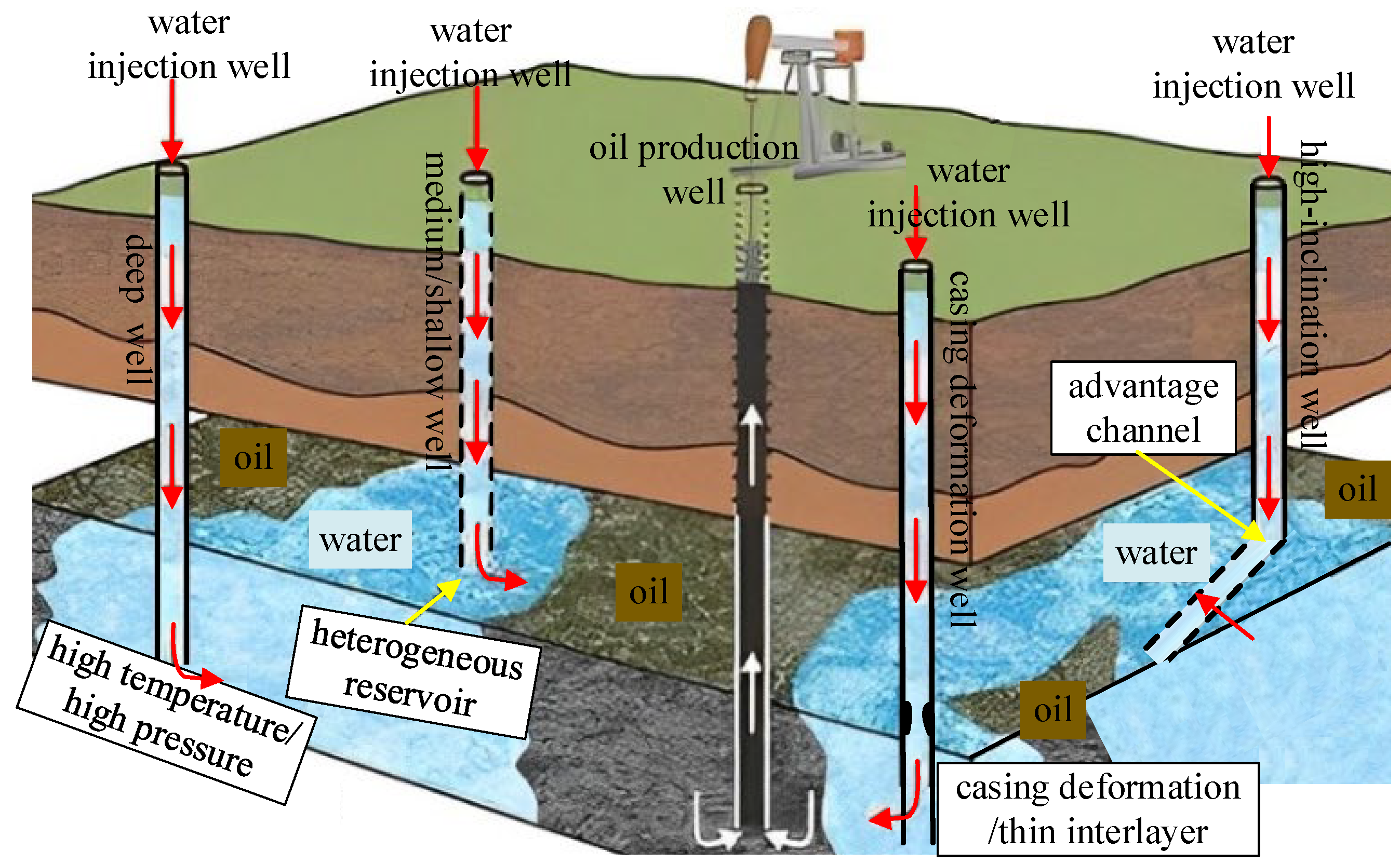

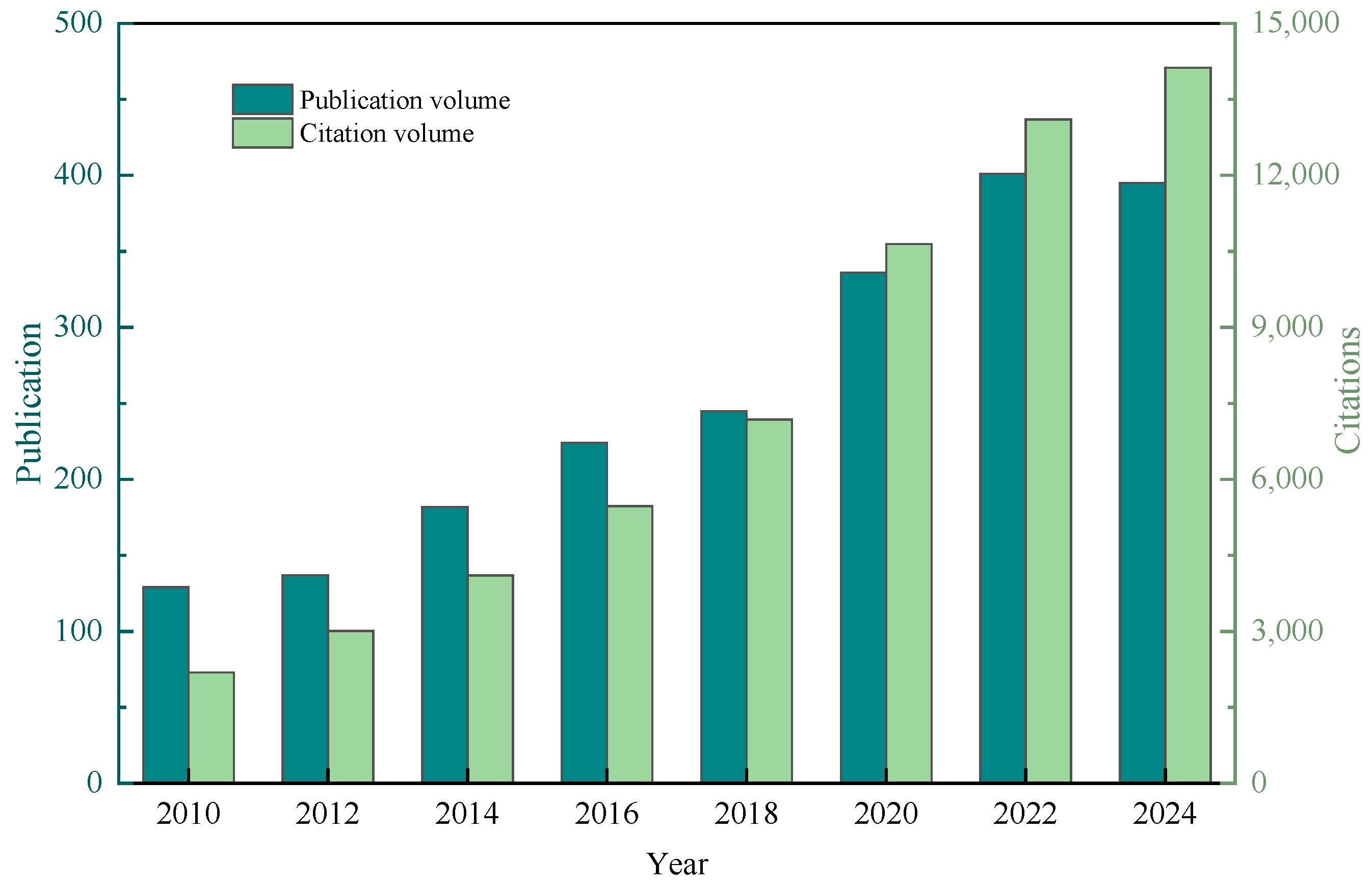
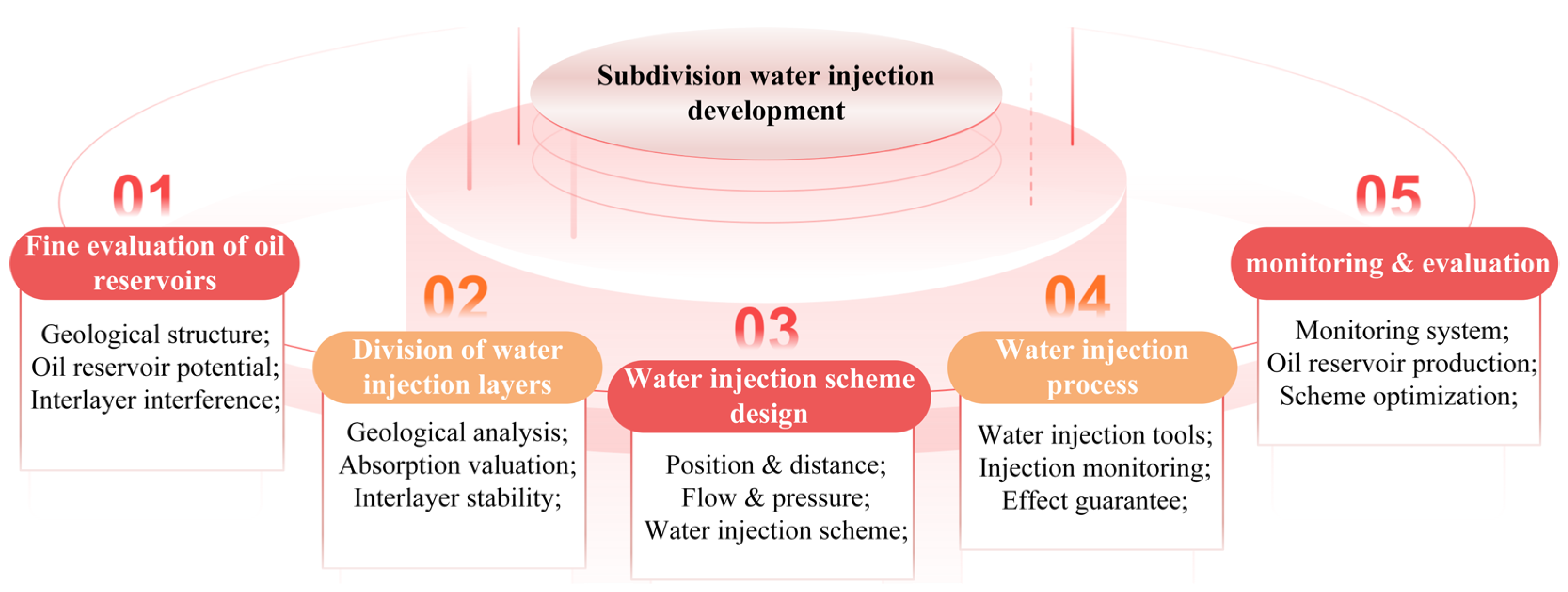
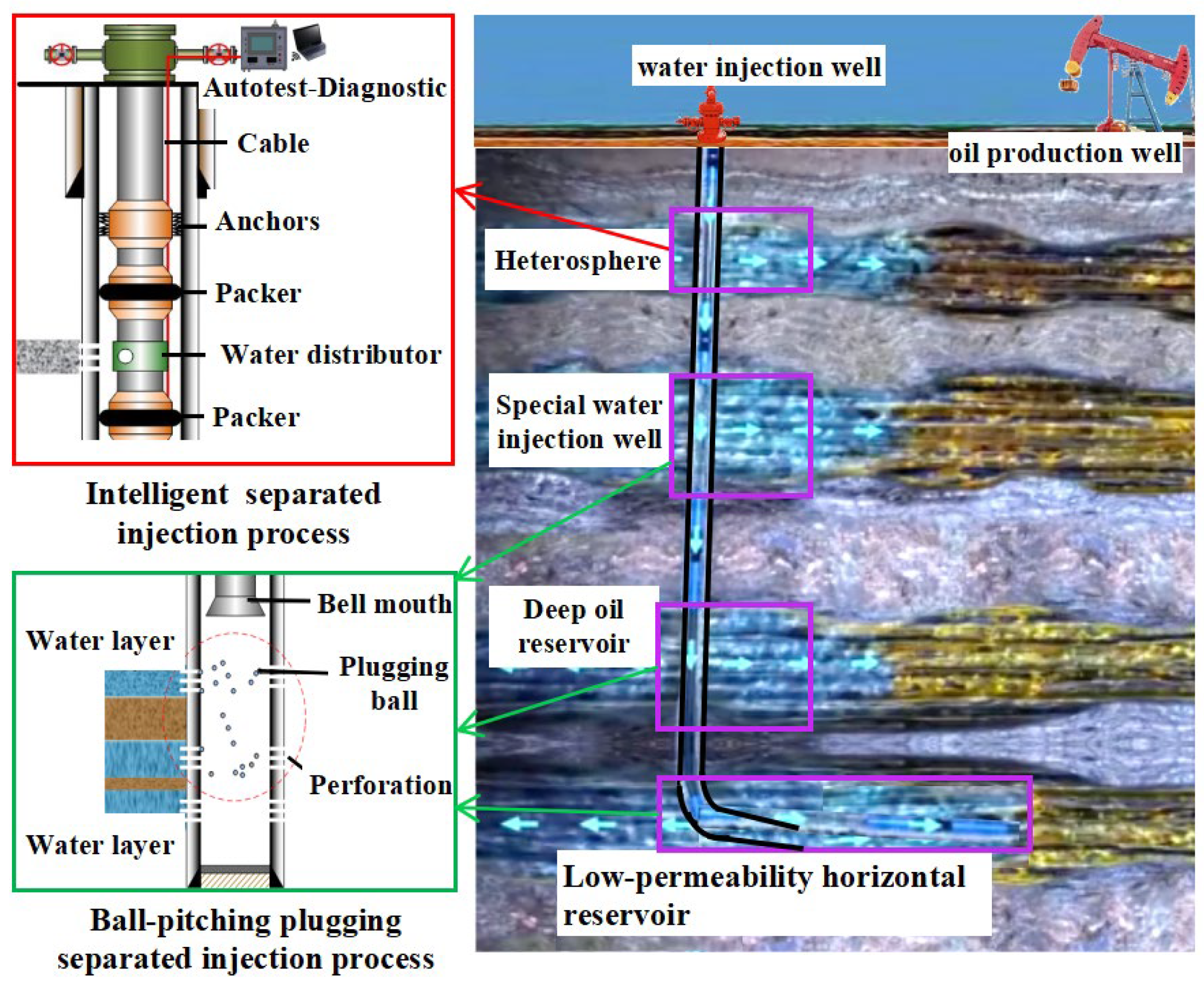



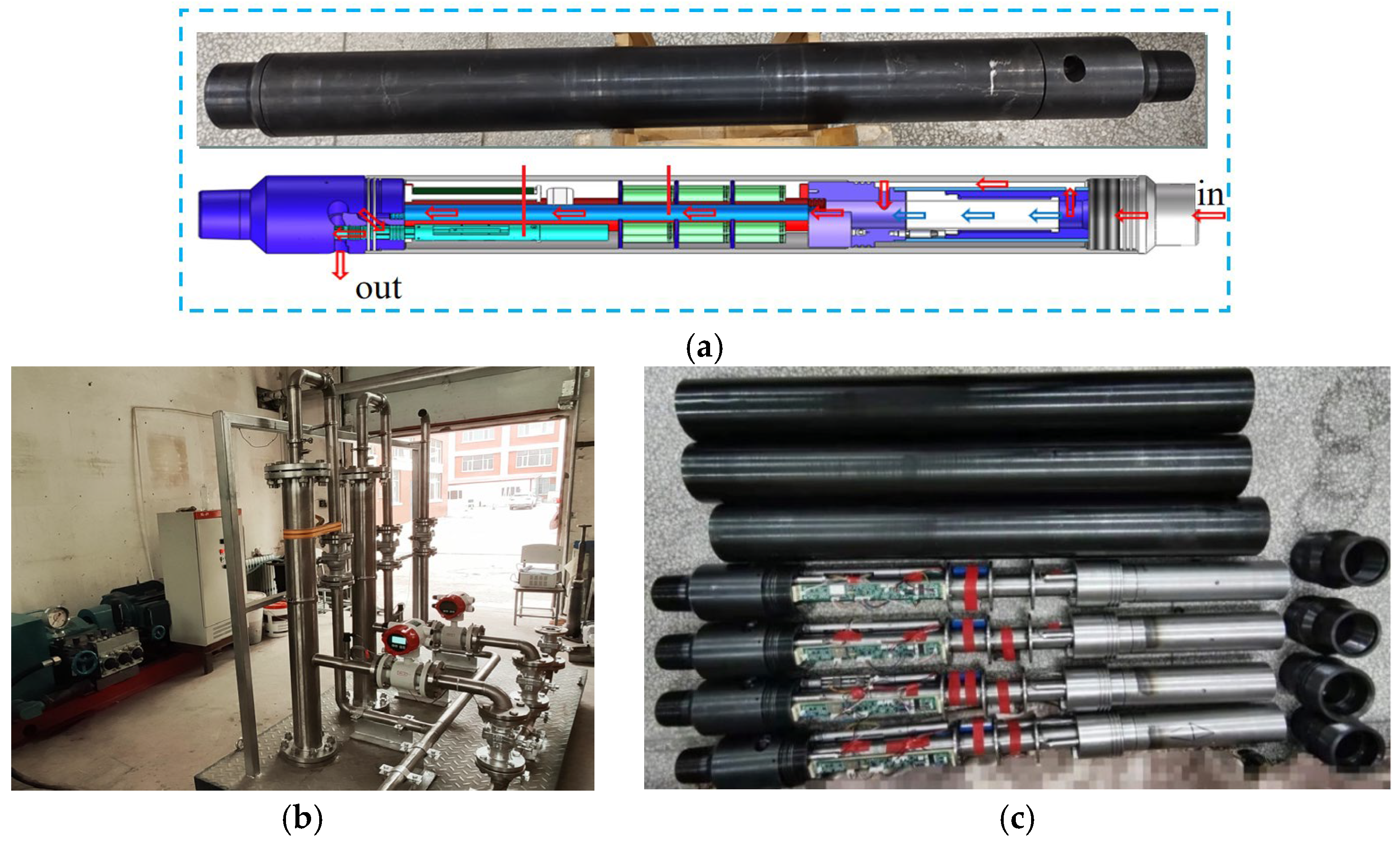


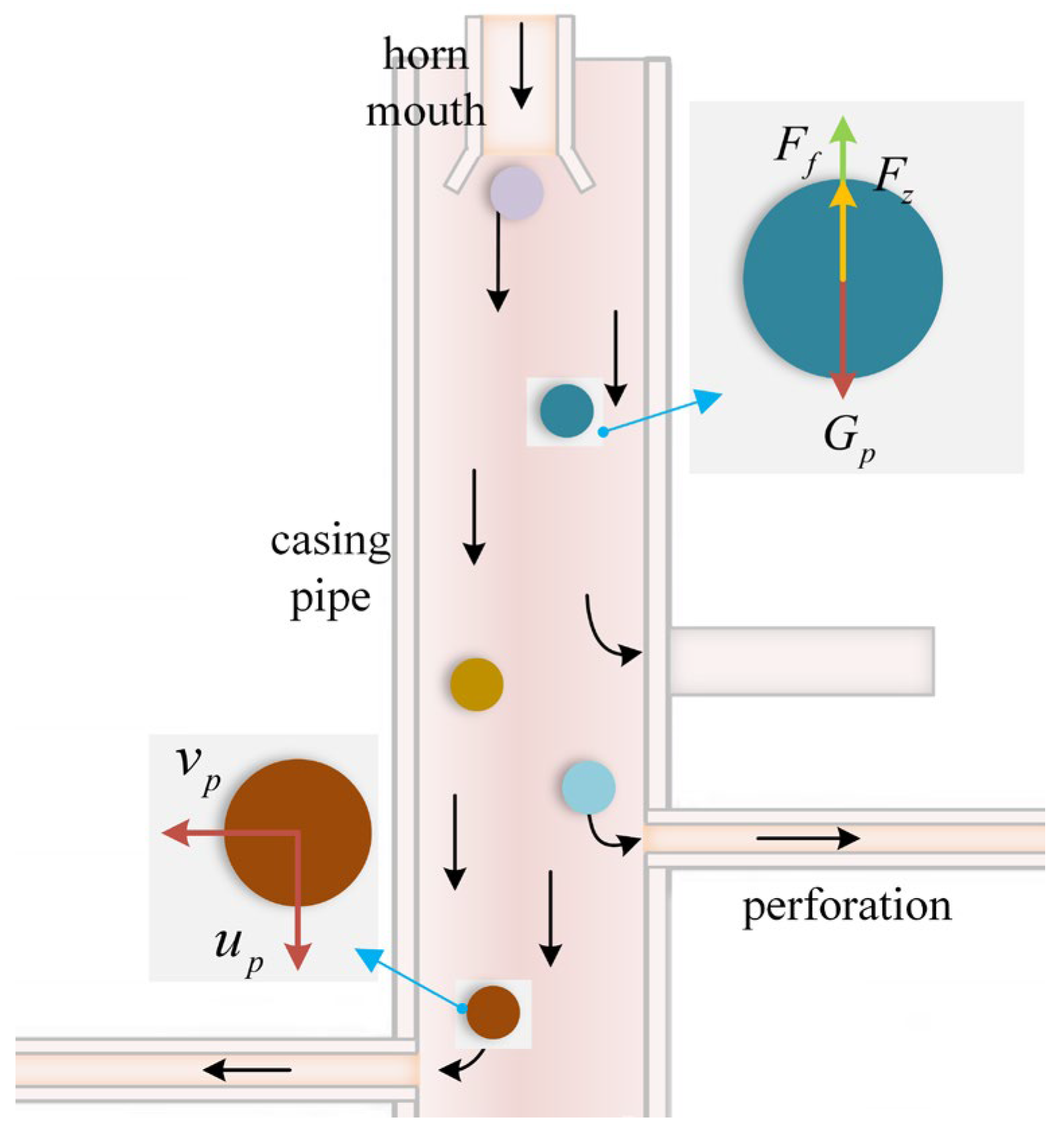
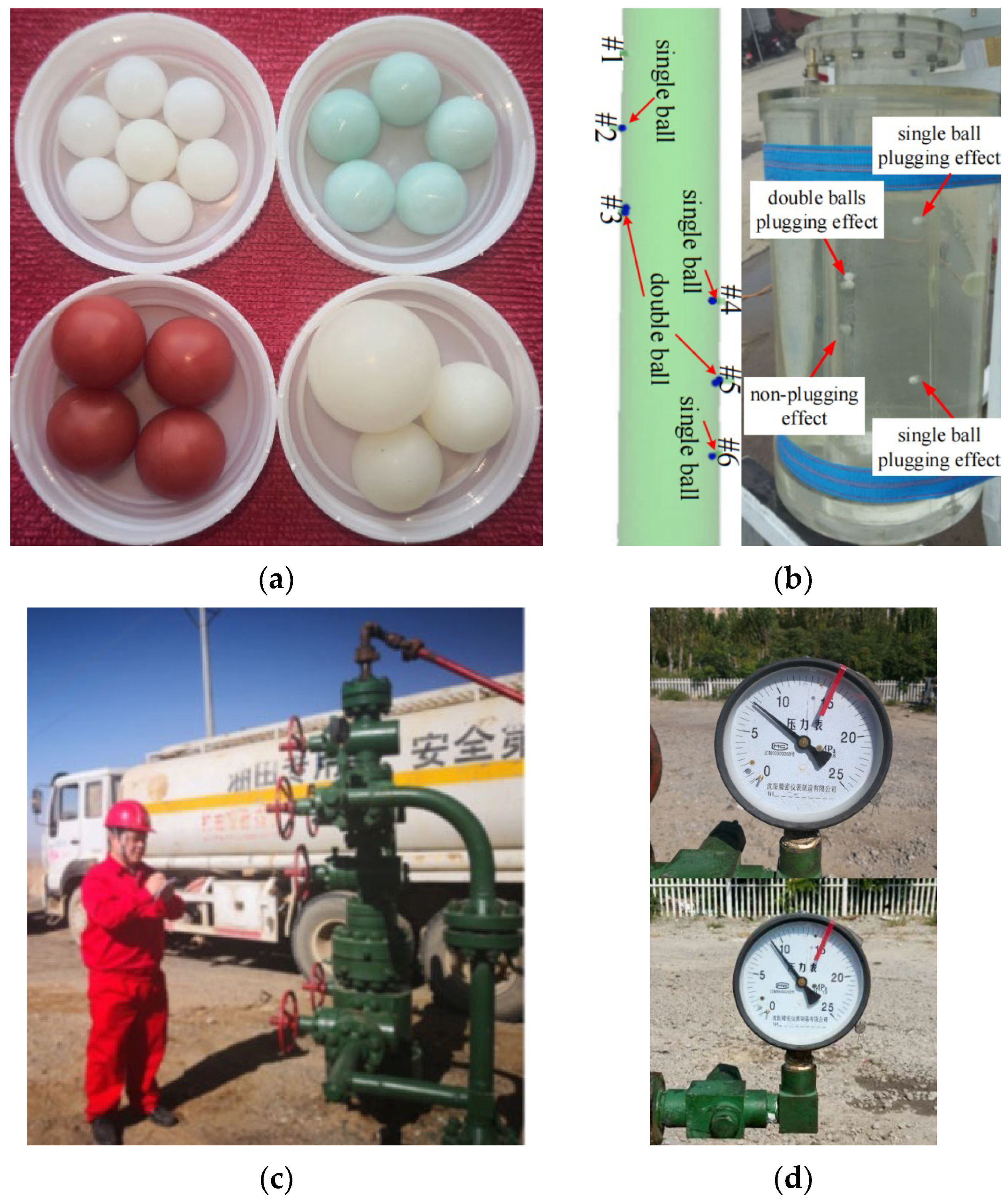
| Process Methods | Applicable Strata | Restricted Strata |
|---|---|---|
| Eccentric layered water injection process [21] | Multi-layered and heterogeneous oil reservoirs | High temperature and high pressure formations, casing deformation, and sand producing formations |
| Concentric layered water injection process [7,21] | Small spacing and small interlayer reservoirs | High temperature and high pressure formations, casing deformation, and sand producing formations |
| Intelligent subdivision process [22] | Complex and unconventional reservoirs | High temperature and high pressure formations, casing deformation, and sand producing formations |
| Fine chemical profile control process [23,24,25,26,27] | Heterogeneous and water flooding late stage reservoir | Low permeability, fault, high temperature and high pressure formations |
| Horizontal well subdivision process [28] | Thin layer, heterogeneous, longitudinally fractured reservoir | High temperature and high pressure formations, faults, and deep well formations |
| Profile Control Type | Material | Technical Advantages | Application Situation |
|---|---|---|---|
| Chemical profile control technology [29,30] | Polyacrylamide | Small effect on the oil reservoir | Poor sealing effect of high permeability layer |
| Cement sodium rosinate | Simple construction | Harmful to the oil reservoir | |
| Composite ion plugging agent | Suitable for complex geological formations | Suitable for deep displacement control | |
| Chromium acetate weak gel | Good oil displacement effect | Limited application scope | |
| Blocking and profile control technology [31,32] | Polyacrylamide gel | Suitable for deep displacement control | Suitable for deep displacement control |
| Pre-crosslinked expanded particles | Suitable for specific reservoir conditions | Improve reservoir fluidity | |
| Microspheres | Capable of achieving deep fluid flow diversion | High oil displacement efficiency |
| Types | Characteristics | Advantages | Disadvantages |
|---|---|---|---|
| Cable-based intelligent injection technology | Using cables to achieve signal transmission between water distributors and control platforms | Stable data transmission and strong real-time performance | Damage-prone cables, high maintenance costs, and large construction difficulties |
| Non-contact intelligent injection technology | Utilizing non-contact sensors and wireless communication technology to achieve data transmission | No need for cable connection, reducing the risk of cable failure; stable and reliable data transmission; low maintenance cost | High requirements for wireless communication technology; affected by complex electromagnetic environment interference |
| Wireless intelligent injection technology | Relying on built-in battery power and wireless communication technology to achieve data transmission | Convenient construction, low maintenance cost, and flexible water injection operation | Limited battery life; stability of communication systems under extreme conditions |
| Characteristic | Deformable Ball | Inner Hard + Outer Rubber Ball | Integral Hard Ball |
|---|---|---|---|
| Material | Deformable material | Outer layer deformation | Hard solid material |
| Tightness | Well-plugging effect | Affected by rubber layer | Diameter difference and smoothness |
| Abradability | Aging | Outer layer wear | Affected by chemical media |
| Reversibility | Low | High | High |
| Cost benefit | Frequent replacement | Good comprehensive benefits | High long-term benefits |
Disclaimer/Publisher’s Note: The statements, opinions and data contained in all publications are solely those of the individual author(s) and contributor(s) and not of MDPI and/or the editor(s). MDPI and/or the editor(s) disclaim responsibility for any injury to people or property resulting from any ideas, methods, instructions or products referred to in the content. |
© 2025 by the authors. Licensee MDPI, Basel, Switzerland. This article is an open access article distributed under the terms and conditions of the Creative Commons Attribution (CC BY) license (https://creativecommons.org/licenses/by/4.0/).
Share and Cite
Ren, F.; Hu, J.; An, Y.; Liu, X.; Wang, B.; Fang, T. Research Progress on Subdivision Water Injection Development Technology for Full-Scale Water Injection Wells. Appl. Sci. 2025, 15, 9492. https://doi.org/10.3390/app15179492
Ren F, Hu J, An Y, Liu X, Wang B, Fang T. Research Progress on Subdivision Water Injection Development Technology for Full-Scale Water Injection Wells. Applied Sciences. 2025; 15(17):9492. https://doi.org/10.3390/app15179492
Chicago/Turabian StyleRen, Fushen, Jinzhao Hu, Yan An, Xiaolong Liu, Baojin Wang, and Tiancheng Fang. 2025. "Research Progress on Subdivision Water Injection Development Technology for Full-Scale Water Injection Wells" Applied Sciences 15, no. 17: 9492. https://doi.org/10.3390/app15179492
APA StyleRen, F., Hu, J., An, Y., Liu, X., Wang, B., & Fang, T. (2025). Research Progress on Subdivision Water Injection Development Technology for Full-Scale Water Injection Wells. Applied Sciences, 15(17), 9492. https://doi.org/10.3390/app15179492






